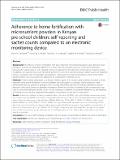| dc.contributor.author | Emily M Teshome, Veronica S Oriaro, Pauline EA Andango, Andrew M Prentice, Hans Verhoef | |
| dc.date.accessioned | 2020-08-14T07:25:42Z | |
| dc.date.available | 2020-08-14T07:25:42Z | |
| dc.date.issued | 2018-11-01 | |
| dc.identifier.uri | https://repository.maseno.ac.ke/handle/123456789/2104 | |
| dc.description.abstract | Background
The efficacy of home fortification with iron-containing micronutrient powders varies between trials, perhaps in part due to population differences in adherence. We aimed to assess to what extent adherence measured by sachet count or self-reporting forms is in agreement with adherence measured by electronic device. In addition, we explored how each method of adherence assessment (electronic device, sachet count, self-reporting forms) is associated with haemoglobin concentration measured at the end of intervention; and to what extent baseline factors were associated with adherence as measured by electronic device.
Methods
Three hundred thirty-eight rural Kenyan children aged 12-36 months were randomly allocated to three treatment arms (home fortification with two different iron formulations or placebo). Home fortificants were … | en_US |
| dc.publisher | BioMed Central | en_US |
| dc.subject | Child, Preschool, Patient compliance, Food, fortified, Iron, Kenya, Self-report | en_US |
| dc.title | Adherence to home fortification with micronutrient powders in Kenyan pre-school children: self-reporting and sachet counts compared to an electronic monitoring device | en_US |
| dc.type | Article | en_US |

